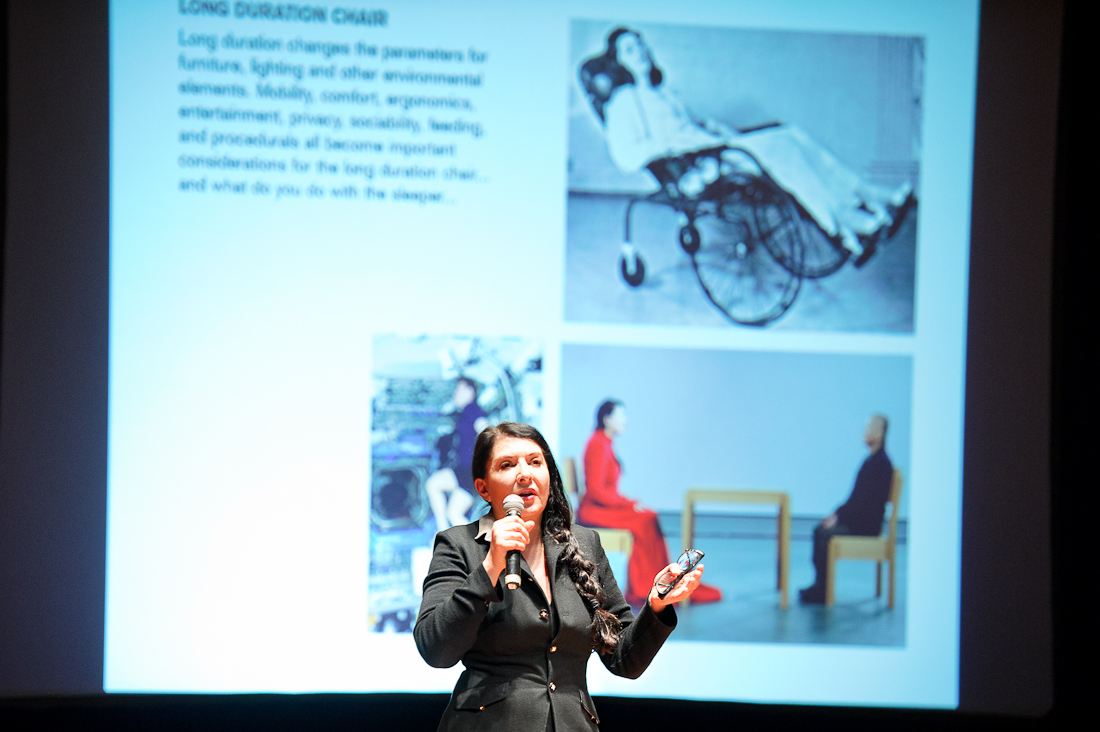
The lights dimmed, and a set of eyes stared out at the audience, stoically, from a projection screen. A voice soon followed, as the video panned out to reveal artist Marina Abramovic in full form. In a clip from her recently released documentary, The Artist is Present, Abramovic explains that embracing silence is essential to the creation of art—and the audience did just that as Abramovic’s voice ceased to accompany her image.
No one knew what was going to happen next on Wednesday evening, as Hamilton community members, as well as visiting art students from the Pratt Institute and Colgate University, awaited Marina Abramovic’s talk in Wellin Hall—the most recent installment of Hamilton’s Visiting Artist Series.
Dean of Faculty Pat Reynolds thanked the audience “for braving the winter that’s finally come to Clinton” to attend the event. Abramovic was scheduled, initially, to speak in the Chapel, but Wednesday afternoon, the art department elected to switch its location in order to accommodate the expected large audience.
“Not only does this series provide wonderful opportunities for the College and greater communities,” Reynolds said. “It also impacts the art curriculum, helping inform students of the work of contemporary artists and develop their own aesthetic discernment.”
Kevin W. Kennedy Professor of Art Katharine Kuharic introduced Abramovic. Kuharic sported a lab coat, her typical work attire, while she spoke.
“I wanted to look nice tonight,” she said. “But Marina saw me in my lab coat, and she asked if I would wear it.”
Kuharic thanked everyone who made the event possible, most notably the members of her department, Dean Reynolds, the Kirkland Endowment, the Dietrich Foundation and, of course, Abramovic herself.
“Marina Abramovic’s body becomes a conduit for grace,” Kuharic said. “Her body is a scapegoat for our cruelties, our terrors.”
Kuharic acknowledged the incredible labor—physical and emotional—that Abramovic’s performances demand:
“The risks, pain, exhaustion, countless hours of preparations and overwhelming numbers of cow bones washed, stars cut in flesh, hours and hours of mournful watch are remarkable—not because they are sensational but because they allow us… to ground ourselves in our senses and attempt to leave our conscious self in search of transcendence.”
When Abramovic took stage, she began by asking, “How do you know when you’re an artist?”
“It’s like breathing,” she explained. “You don’t ask yourself if you breathe; you just have to, or you die.”
But Abramovic quickly qualified this statement, saying that even when art feels as natural as breathing, it still may not be good art. “Good artists… have to sacrifice everything,” she said.
Abramovic knows sacrifice well. She related to the audience several tales of loss, including her departure from Belgrade and her split with former artistic and romantic partner, Ulay. While art motivated some of the painful decisions Abramovic had to make in her life, it also enabled her to cope with them.
“We need art in the places where we disconnect from ourselves,” she said. “There, artists have a function.”
Abramovic highlighted the role of artists as “servants of society,” rather than figures motivated by fame and fortune. She described this notion of the artist as “passé.”
“Artists today are so much more responsible than before,” she said.
And their responsibility, Abramovic said, is not only to address present world issues but to guide the generations to come, as well. She urged the necessity for “multiple layers of meaning”—insurance for art’s utility in the future.
Abramovic named “three basic fears” that are inherent in all people: dying, suffering and pain. “I stage… my fears in the form of performance,” she said.
Performance, Abramovic explained, is not so much a viewing experience as an interaction between audience and artist. In a good performance, she said, the artist functions as a “mirror.” When the “energy” of the audience faces this “mirror,” a transformation takes place.
Abramovic insisted that reproductions of performances are simply “documents;” “you have to be there” to have the transformative experience that good performance can provide for an audience.
She shared with Wellin’s audience several such “documents” of what she deemed exemplar performance art—videos she had edited to showcase different parts of the body in performance.
When she experienced some technical difficulties with her videos, Abramovic took it in stride. “This is the moment for a performance joke,” she said. “I only know one: How many performance artists does it take to fix a light bulb?”
The punch line—“I don’t know; I was there only six hours”—emphasizes the long duration of many performances.
Abramovic recognizes that most people do not know how to view these lengthy performances. As a remedy to this, she has developed an “Abramovic method,” which she plans to teach at the Marina Abramovic Institute (MAI) in Hudson, NY when it opens this year. MAI will serve in part as a venue for performances of all kinds, as well as an educational center for performers and spectators alike.
“My workshops are pretty successful,” Abramovic said, “but you hate me at the beginning.”
“I hope you come,” she added.
Posted March 1, 2012
